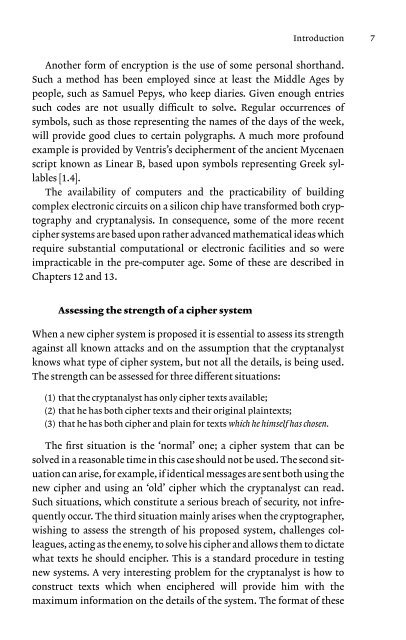Code and ciphers: Julius Caesar, the Enigma and the internet
Code and ciphers: Julius Caesar, the Enigma and the internet
Code and ciphers: Julius Caesar, the Enigma and the internet
You also want an ePaper? Increase the reach of your titles
YUMPU automatically turns print PDFs into web optimized ePapers that Google loves.
Ano<strong>the</strong>r form of encryption is <strong>the</strong> use of some personal shorth<strong>and</strong>.<br />
Such a method has been employed since at least <strong>the</strong> Middle Ages by<br />
people, such as Samuel Pepys, who keep diaries. Given enough entries<br />
such codes are not usually difficult to solve. Regular occurrences of<br />
symbols, such as those representing <strong>the</strong> names of <strong>the</strong> days of <strong>the</strong> week,<br />
will provide good clues to certain polygraphs. A much more profound<br />
example is provided by Ventris’s decipherment of <strong>the</strong> ancient Mycenaen<br />
script known as Linear B, based upon symbols representing Greek syllables<br />
[1.4].<br />
The availability of computers <strong>and</strong> <strong>the</strong> practicability of building<br />
complex electronic circuits on a silicon chip have transformed both cryptography<br />
<strong>and</strong> cryptanalysis. In consequence, some of <strong>the</strong> more recent<br />
cipher systems are based upon ra<strong>the</strong>r advanced ma<strong>the</strong>matical ideas which<br />
require substantial computational or electronic facilities <strong>and</strong> so were<br />
impracticable in <strong>the</strong> pre-computer age. Some of <strong>the</strong>se are described in<br />
Chapters 12 <strong>and</strong> 13.<br />
Assessing <strong>the</strong> strength of a cipher system<br />
When a new cipher system is proposed it is essential to assess its strength<br />
against all known attacks <strong>and</strong> on <strong>the</strong> assumption that <strong>the</strong> cryptanalyst<br />
knows what type of cipher system, but not all <strong>the</strong> details, is being used.<br />
The strength can be assessed for three different situations:<br />
(1) that <strong>the</strong> cryptanalyst has only cipher texts available;<br />
(2) that he has both cipher texts <strong>and</strong> <strong>the</strong>ir original plaintexts;<br />
(3) that he has both cipher <strong>and</strong> plain for texts which he himself has chosen.<br />
Introduction 7<br />
The first situation is <strong>the</strong> ‘normal’ one; a cipher system that can be<br />
solved in a reasonable time in this case should not be used. The second situation<br />
can arise, for example, if identical messages are sent both using <strong>the</strong><br />
new cipher <strong>and</strong> using an ‘old’ cipher which <strong>the</strong> cryptanalyst can read.<br />
Such situations, which constitute a serious breach of security, not infrequently<br />
occur. The third situation mainly arises when <strong>the</strong> cryptographer,<br />
wishing to assess <strong>the</strong> strength of his proposed system, challenges colleagues,<br />
acting as <strong>the</strong> enemy, to solve his cipher <strong>and</strong> allows <strong>the</strong>m to dictate<br />
what texts he should encipher. This is a st<strong>and</strong>ard procedure in testing<br />
new systems. A very interesting problem for <strong>the</strong> cryptanalyst is how to<br />
construct texts which when enciphered will provide him with <strong>the</strong><br />
maximum information on <strong>the</strong> details of <strong>the</strong> system. The format of <strong>the</strong>se

















